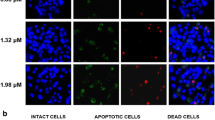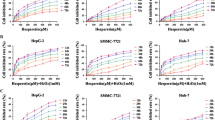Abstract
Although plant-derived flavonoids have been reported to have anti-cancer activities, the exact mechanism of these actions is not completely understood. In this study we investigated the role for reactive oxygen species (ROS) as a mediator of the apoptosis induced by apigenin, a widespread flavonoid in plant, in HepG2 human hepatoma cells. Apigenin reduced cell viability, and induced apoptotic cell death in a dose-dependent manner. In addition, it evoked a dose-related elevation of intracellular ROS level. Treatment with various inhibitors of the NADPH oxidase (diphenylene iodonium, apocynin, neöpterine) significantly blunted both the generation of ROS and induction of apoptosis induced by apigenin. These results suggest that ROS generated through the activation of the NADPH oxidase may play an essential role in the apoptosis induced by apigenin in HepG2 cells. These results further suggest that apigenin may be valuable for the therapeutic management of human hepatomas.
Similar content being viewed by others
References
Babior, B. M., The respiratory burst oxidase.Curr. Opin. Hematol., 2, 55–60 (1995).
Babior, B. M., NADPH oxidase: an update.Blood, 93, 1464- 1476 (1999).
Bhimani, R. S., Troll, W., Grunberger, D., and Frenkel, K., Inhibition of oxidative stress in HeLa cells by chemopreventive agents.Cancer Res., 53, 4528–4533 (1993).
Bohler, T., Waiser, J., Hepburn, H., Gaedeke, J., Lehmann, C, Hambach, P., Budde, K., and Neumayer, H. H., TNF-a and IL-1 induce apoptosis in subconfluent rat mesangial cells. Evidence for the involvement of hydrogen peroxide and lipid peroxidation as second messengers.Cytokine, 12, 986–991 (2000).
Bombeli, T., Karsan, A., Tait, J. R, and Harlan, J. M., Apoptotic vascular endothelial cells become procoagulant.Blood, 89, 2429–2442 (1997).
Brusselmans, K., Vrolix, R., Verhoeven, G and Swinnen, J. V, Induction of cancer cell apoptosis by flavonoids is associated with their ability to inhibit fatty acid synthase activity.J. Biol. Chem., 280, 5636–5645 (2005).
Caltagirone, S., Rossi, C, Poggi, A., Ranelletti, F. O., Natali, P. G, Brunetti, M., Aiello, F. B., and Piantelli, M., Flavonoids apigenin and quercetin inhibit melanoma growth and metastatic potential.Int. J. Cancer, 87, 595–600 (2000).
Cao, G, Sofic, E., and Prior, R. L, Antioxidant and prooxidant behavior of flavonoids: structure-activity relationships.Free Radic. Biol. Med., 22, 749–760 (1997).
Chiao, C, Carothers, A. M., Grunberger, D., Solomon, G, Preston, G A., and Barrett, J. C, Apoptosis and altered redox state induced by caffeic acid phenethyl ester (CAPE) in transformed rat fibroblast cells.Cancer Res., 55, 3576–3583 (1995).
Choudhury, Q. G, McKay, D. T, Flower, R. J., and Croxtall, J. D., Investigation into the involvement of phospholipases A2 and MAP kinases in modulation of AA release and cell growth in A549 cells.Br. J. Pharmacol., 131, 255–265 (2000).
Cool, R. H., Merten, E., Theiss, C, and Acker, H., Rac1, and not Rac2, is involved in the regulation of the intracellular hydrogen peroxide level in HepG2 cells.Biochem. J., 332, 5–8 (1998).
Daniels, I., Lindsay, M. A., Keany, C. I., Burden, R. P., Fletcher, J., and Haynes, A. P., Role of arachidonic acid and its metabolites in the priming of NADPH oxidase in human polymorphonuclear leukocytes by peritoneal dialysis effluent.Clin. Diagn. Lab. Immunol., 5, 683–689 (1998).
Das, A., Banik, N. L, and Ray, S. K., Mechanism of apoptosis with the involvement of calpain and caspase cascades in human malignant neuroblastoma SH-SY5Y cells exposed to flavonoids.Int. J. Cancer, 119, 2575–2585 (2006).
Ehleben, W., Porwol, T, Fandrey, J., Kummer, W., and Acker, H., Cobalt and desferrioxamine reveal crucial members of the oxygen sensing pathway in HepG2 cells.Kidney Int., 51, 483–491 (1997).
Fleming, I. N., Elliott, C. M., Buchanan, F. G, Downes, C. P., and Exton, J. H., Ca2/calmodulin-dependent protein kinase II regulates Tiam1 by reversible protein phosphorylation.J. Biol. Chem., 274, 12753–12758 (1999).
Fotsis, T., Pepper, M. S., Montesano, R., Aktas, E., Breit, S., Schweigerer, L., Rasku, S., Wahala, K., and Adlercreutz, H., Phytoestrogens and inhibition of angiogenesis, Baillieres Clin.Endocrinol. Metab., 12, 649–666 (1998).
Fujisawa, H., Regulation of the activities of multifunctional Ca2+/ calmodulin-dependent protein kinases.J. Biochem. (Tokyo), 129, 193–199 (2001).
Gupta, S., Afaq F. and Mukhtar, H., Involvement of nuclear factor-KB, Bax and Bcl-2 in induction of cell cycle arrest and apoptosis by apigenin in human prostate carcinoma cells.Oncogene, 21, 3727–3738 (2002).
Halliwell, B., Free radicals, reactive oxygen species and human disease: a critical evaluation with special reference to atherosclerosis.Br. J. Exp. Pathol., 70, 737–757 (1989).
Havsteen, B. H., The biochemistry and medical significance of the flavonoids.Pharmacol. Then, 96, 67–202 (2002).
Jones, S. A., O’Donnell, V. B., Wood, J. D., Broughton, J. P., Hughes, E. J., and Jones, O. T., Expression of phagocyte NADPH oxidase components in human endothelial cells.Am. J. Physiol., 271, H1626–1634 (1996).
Kidd, V. J., Proteolytic activities that mediate apoptosis.Annu. Rev. Physiol., 60, 533–573 (1998).
Kojima, S., Nomura, T., Icho, T., Kajiwara, Y, Kitabatake, K., and Kubota, K., Inhibitory effect of neopterin on NADPH-dependent superoxide-generating oxidase of rat peritoneal macrophages.FEBS Lett., 329, 125–128 (1993).
Kornblau, S. M., The role of apoptosis in the pathogenesis, prognosis, and therapy of hematologic malignancies.Leukemia, 12 Suppl1, S41–46 (1998).
Kummer, W. and Acker, H., Immunohistochemical demonstration of four subunits of neutrophil NAD(P)H oxidase in type I cells of carotid body.J. Appl. Physiol., 78, 1904–1909 (1995).
LaBel, C. P., Ischiopoulos, H., and Bondy, S. C, Evaluation of the probe 2′,7′-dichlorofluorescin as an indicator of reactive oxygen species formation and oxidative stress.Chem. Res. Toxicol., 5, 227–231 (1992).
Lee, Y S., Kang, Y. S., Lee, J. S., Nicolova, S., and Kim, J. A., Involvement of NADPH oxidase-mediated generation of reactive oxygen species in the apototic cell death by capsaicin in HepG2 human hepatoma cells.Free Radic. Res., 8, 405–412 (2004).
Lee, Y S., Kang, Y S., Lee, S. H., and Kim, J. A., Role of NAD(P)H oxidase in the tamoxifen-induced generation of reactive oxygen species and apoptosis in HepG2 human hepatoblastoma cells.Cell Death Differ, 7, 925–932 (2000).
Lowe, S. W. and Lin, A. W., Apoptosis in cancer.Carcinogenesis, 21, 485–495 (2000).
Marshall, C, Mamary, A. J., Verhoeven, A. J., and Marshall, B. E., Pulmonary artery NADPH oxidase is activated in hypoxic pulmonary vasoconstriction.Am. J. Respir. Cell Mol. Biol., 15, 633–644 (1996).
McKay, D. L. and Blumberg, J. B., A review of the bioactivity and potential health benefits of chamomile tea(Matricaria recutita L).Phytother Res., 20, 519–530 (2006).
Morrissey, C, O’Neill, A., Spengler, B., Christoffel, V, Fitzpatrick, J. M., and Watson, R. W., Apigenin drives the production of reactive oxygen species and initiates a mitochondrial mediated cell death pathway in prostate epithelial cells.Prostate, 63, 131–142 (2005).
O’Donnell, B. V, Tew, D. G, Jones, O. T, and England, P. J., Studies on the inhibitory mechanism of iodonium compounds with special reference to neutrophil NADPH oxidase.Bio-chem. J., 290, 41–49 (1993).
Patel, D., Shukla, S., and Gupta, S., Apigenin and cancer chemoprevention: progress, potential and promise (review).Int. J. Oncol., 30, 233–245 (2007).
Peterson, J. and Dwyer, J., Flavonoids: dietary occurrence and biochemical activity.Nutr. Res., 18, 1995–2018 (1988).
Schiaffonati, L. and Tiberio, L, Gene expression in liver after toxic injury: analysis of heat shock response and oxidative stress-inducible genes.Liver, 17, 183–191 (1997).
Sergediene, E., Jonsson, K., Szymusiak, H., Tyrakowska, B., Rietjens, I. M., and Cenas, N., Prooxidant toxicity of polyphenolic antioxidants to HL-60 cells: description of quantitative structure-activity relationships.FEBS Lett., 462, 392- 396 (1999).
Shen, H. M., Shi, C. Y, and Ong, C. N., Detection of elevated reactive oxygen species level in cultured rat hepatocytes treated with aflatoxin B1.Free Rad. Biol. Med., 21, 139–146 (1996).
Shiose, A. and Sumimoto, H., Arachidonic acid and phosphorylation synergistically induce a conformational change of p47phox to activate the phagocyte NADPH oxidase.J. Biol. Chem., 275, 13793–13801 (2000).
Simon, H. U., Haj-Yehia, A., and Levi-Schaffer, F, Role of reactive oxygen species (ROS) in apoptosis induction.Apoptosis, 5, 415–418 (2000).
Song, Z. and Steller, H., Death by design: mechanism and control of apoptosis.Trends Cell. Biol., 9, 49–52 (1999).
Stolk, J., Hiltermann, T. J., Dijkman, J. H., and Verhoeven, A. J., Characteristics of the inhibition of NADPH oxidase activation in neutrophils by apocynin, a methoxy-substituted catechol.Am. J. Respir. Cell Mol. Biol., 11, 95–102 (1994).
Suzukawa, K., Miura, K., Mitsushita, J., Resau, J., Hirose, K., Crystal, R., and Kamata, T, Nerve growth factor-induced neuronal differentiation requires generation of Rac1-regulated reactive oxygen species.J. Biol. Chem., 275, 13175- 13178 (2000).
vanAcker, S. A., van den Berg, D. J., Tramp, M. N., Griffioen, D. H., van Bennekom, W. P., van der Vijgh, W. J., and Bast, A., Structural aspects of antioxidant activity of flavonoids.Free Radie. Biol. Med., 20, 331–342 (1996).
van de Loosdrecht, A. A., Nennie, E., Ossenkoppele, G J., Beelen, R. H., and Langenhuijsen, M. M., Cell mediated cytotoxicity against U 937 cells by human monocytes and macrophages in a modified colorimetric MTT assay. A methodological study.J. Immunol. Methods, 141, 15–22 (1991).
van Dross, R. T, Hong, X., and Pelling, J. C, Inhibition of TPA- induced cydooxygenase-2 (COX-2) expression by apigenin through downregulation of Akt signal transduction in human keratinocytes.Mol. Carcinog., 44, 83–91 (2005).
Vargo, M. A., Voss, O. H., Poustka, F., Cardounel, A. J., Grotewold, E., and Doseff, A. I., Apigenin-induced-apoptosis is mediated by the activation of PKCS and caspases in leukemia cells.Biochem. Pharmacol., 72, 681–692 (2006).
Vermes, I., Haanen, C, Steffens-Nakken, H., and Reutelingsperger, C, A novel assay for apoptosis. Flow cytometric detection of phosphatidylserine expression on early apoptotic cells using fluorescein labelled Annexin V.J. Immunol. Methods, 184, 39–51 (1995).
Wang, I. K., Lin-Shiau, S. Y, and Lin, J. K., Induction of apoptosis by apigenin and related flavonoids through cytochrome c release and activation of caspase-9 and caspase-3 in leukaemia HL-60 cells.Eur. J. Cancer, 35, 1517–15125 (1999).
Wang, W., Heideman, L, Chung, C. S., Pelling, J. C, Koehler, K. J., and Birt, D. R, Cell-cycle arrest at G2/M and growth inhibition by apigenin in human colon carcinoma cell lines.Mol. Carcinog., 28, 102–110 (2000).
Way, T. D., Kao, M. C, and Lin, J. K., Apigenin induces apoptosis through proteasomal degradation of HER2/neu in HER2/ neu-overexpressing breast cancer cells via the phosphatidylinositol 3-kinase/Akt-dependent pathway.J. Biol. Chem., 279, 4479–4489 (2004).
Williams, R. J., Spencer J. P., and Rice-Evans, C, Flavonoids: antioxidants or signalling molecules?Free Radic. Biol. Med., 36, 838–849 (2004).
Youngson, C, Nurse, C, Yeger, H., Curnutte, J. T., Vollmer, C, Wong, V, and Cutz, E., Immunocytochemical localization on O2-sensing protein (NADPH oxidase) in chemoreceptor cells.Microsc. Res. Tech., 37, 101–106 (1997).
Yu, B. P., Cellular defenses against damage from reactive oxygen species.Physiol. Rev., 74, 139–162 (1994).
Zheng, P. W., Chiang, L. C, and Lin, C. C, Apigenin induced apoptosis through p53-dependent pathway in human cervical carcinoma cells.Life Sci., 76, 1367–1379 (2005).
Author information
Authors and Affiliations
Corresponding author
Rights and permissions
About this article
Cite this article
Choi, S.I., Jeong, C.S., Cho, S.Y. et al. Mechanism of apoptosis induced by apigenin in hepg2 human hepatoma cells: involvement of reactive oxygen species generated by NADPH oxidase. Arch. Pharm. Res. 30, 1328–1335 (2007). https://doi.org/10.1007/BF02980274
Received:
Issue Date:
DOI: https://doi.org/10.1007/BF02980274




